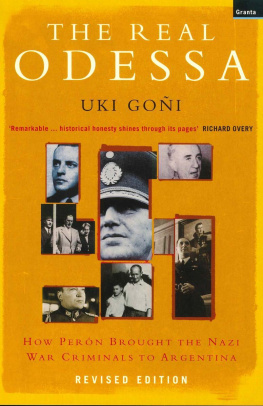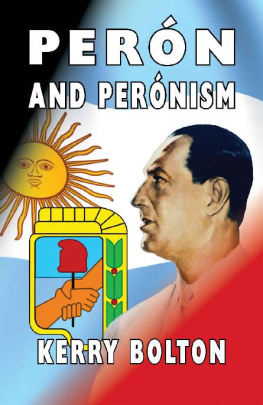PROLOGUE
Estas cosas pense en la Recoleta
en el lugar de mi ceniza.
These thoughts came to me in the Recoleta
in the place where my ashes will lie.
Jorge Luis Borges
In the early hours of October 22, 1976, an Argentine army truck loaded with well-armed troops drove out through the gates of the presidential residence in Olivos and headed towards Buenos Aires, a few miles away. It was followed by an ambulance, which in turn was followed by another truck. The convoy drove through the still dark streets of the capital to Recoleta Cemetery, a little city of the dead where the bodies of presidents, generals, and other illustrious Argentines are housed in rows of opulent, mansion-sized vaults along avenues lined with cyprus trees. It is the place to be buried in Argentina, the most fashionable necropolis in a country where the dead, like the living, are judged by their houses. Thirteen of the countrys presidents are there. So is Luis. Angel Firpo, the Wild Bull of the Pampas, who earned his place in the national pantheon with a punch that knocked Jack Dempsey out of the ring, although Dempsey climbed back in to beat him. Outside his vault stands a bigger than life size bronze statue of the Bull in his dressing gown and fighting boots. Around him, in the cemeterys bleak, grassless chaos of marble and granite, soaring spires and domes cast shadows on generals on horseback and politicians exhorting invisible crowds. Bronze scrolls on the vaults list the inhabitants honours. Inside, ornate coffins are draped with lace, lined with candles, and decorated with flowers. There are chairs for living visitors. Circular stairways wind down into the earth where other family members are buried. The place is full. Theres an Argentine saying: Its easier to get into heaven than into Recoleta.
Understandably, it is one of the most popular attractions in Argentina. More than a thousand people stroll down Recoletas cold streets every day not only the old women, the regulars at every cemetery with their bunches of fresh flowers, but also the tourist groups from the provinces with cameras and school children in white smocks on their class outing stare at the houses of the famous dead.
But there were no visitors on that chill morning of October 22. It was too early for the old women, and, anyway, the cemetery was ringed by policemen carrying sub-machine guns to deter the curious as the convoy of army trucks and ambulance ground to a halt outside the doric portico of Recoletas front entrance. Two cemetery workers, called in for special duty, helped unload a coffin that was covered by a mattress so that no one, not even the soldiers, could take a peak at the face of the woman who lay serenely beneath the glass top. Surrounded by their military guard, the workers carried the coffin along one of the avenues, then down a narrow side street, stopping in front of a black marble crypt belonging to the Familia Duarte. They carried it inside. There was no ceremony. The workmen removed the mattress and quickly left, slamming the ornate steel gate locked behind them. The soldiers were nervous and in a hurry, said one of the workers later. They just wanted to plant her and get out of there.
The nervousness of the soldiers was understandable. They had just planted Eva Pern, the long dead wife of former President Juan Pern and the beloved Saint Evita of millions of adoring Argentines. It was the second time in almost quarter of a century that the military, who so often rule Argentina, had hurriedly disposed of Evas body in a desperate effort to purge their country of the turbulent passions inspired by her name. During her lifetime, at the height of her career in the late 1940s, Maria Eva Duarte de Pern was one of the most loved and hated, powerful and capricious women in Argentina and the world.
When she died in 1952, her widower, President Pern, was never able to persuade his people that he was now the substance and she the shadow. Within three years, Pern had been overthrown, fleeing into exile aboard a Paraguayan gunboat. Argentinas long-repressed anti-Pernists erased every physical vestige of Evita. Bulldozers tore down her monuments. Her pictures, books, personal papers were burned in public bonfires. Even her body disappeared from the Confederation of Labour headquarters where it had been kept to await the completion of a multi-million dollar mausoleum, which was to be taller than the Statue of Liberty.
For sixteen years the body of Evita Pern was missing. But in Argentina, the cult of Saint Evita flourished, dooming every attempt by the nations generals to return the government to stable civilian rule. Posters of an ethereal Evita plastered the walls of every town and village in the country. Terrorists killed in her name. The president who had taken power soon after Juan Pern was overthrown was kidnapped and murdered in an unsuccessful effort to make him tell where Evitas body had been hidden. Finally, however, the Argentine Army capitulated. In Lot 86, Garden 41 in Musocco Cemetery in Milan, Italy, the body of Maria Maggi, an Italian woman who had died in Argentina, was exhumed. The coffins wooden casing was rotting. But the coffin itself, of silver with a glass window, was in excellent condition. So was the corpse. It was the embalmed body of Evita Pern.
Over two decades, she travelled far and wide a macabre odyssey across five countries of two continents. Now that she has been interred in Argentine soil, perhaps her fellow countrymen will let her rest in peace. But it is doubtful. There is a macabre, almost necrophiliac love of the dead in the soul of the Argentine people. Famous cadavers have often stood for national causes in the years since the country won its independence from Spain in 1810. It is as if the body had become the flag of political battle. Possession is everything, in a way it is like owning a splinter of the True Cross. There is also the terror of it falling into the hands of the enemy the fear of defilement. In the early days of the nation when a provincial










